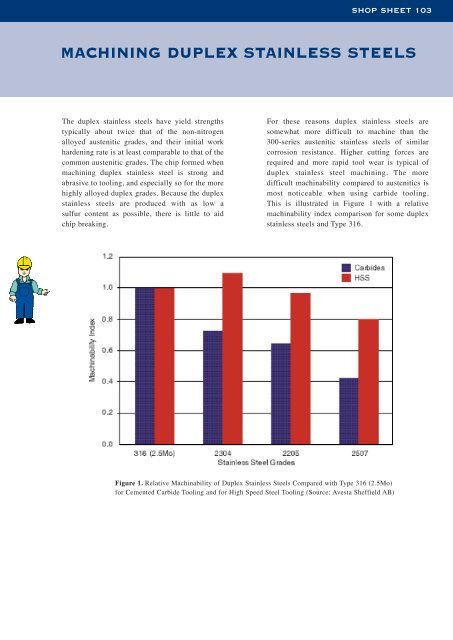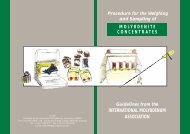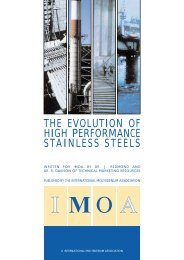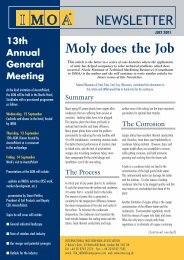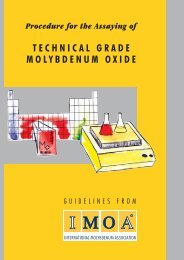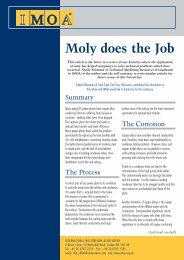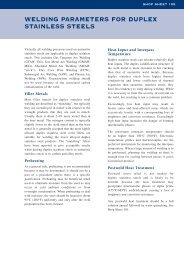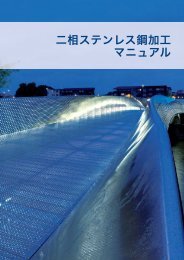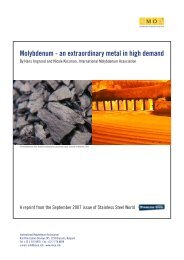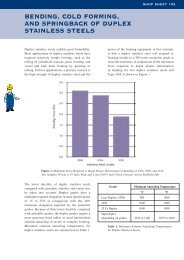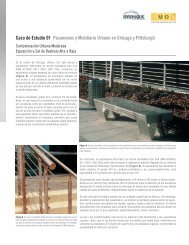103: Machining duplex stainless steels - IMOA
103: Machining duplex stainless steels - IMOA
103: Machining duplex stainless steels - IMOA
You also want an ePaper? Increase the reach of your titles
YUMPU automatically turns print PDFs into web optimized ePapers that Google loves.
SHOP SHEET <strong>103</strong><br />
MACHINING DUPLEX STAINLESS STEELS<br />
The <strong>duplex</strong> <strong>stainless</strong> <strong>steels</strong> have yield strengths<br />
typically about twice that of the non-nitrogen<br />
alloyed austenitic grades, and their initial work<br />
hardening rate is at least comparable to that of the<br />
common austenitic grades. The chip formed when<br />
machining <strong>duplex</strong> <strong>stainless</strong> steel is strong and<br />
abrasive to tooling, and especially so for the more<br />
highly alloyed <strong>duplex</strong> grades. Because the <strong>duplex</strong><br />
<strong>stainless</strong> <strong>steels</strong> are produced with as low a<br />
sulfur content as possible, there is little to aid<br />
chip breaking.<br />
For these reasons <strong>duplex</strong> <strong>stainless</strong> <strong>steels</strong> are<br />
somewhat more difficult to machine than the<br />
300-series austenitic <strong>stainless</strong> <strong>steels</strong> of similar<br />
corrosion resistance. Higher cutting forces are<br />
required and more rapid tool wear is typical of<br />
<strong>duplex</strong> <strong>stainless</strong> steel machining. The more<br />
difficult machinability compared to austenitics is<br />
most noticeable when using carbide tooling.<br />
This is illustrated in Figure 1 with a relative<br />
machinability index comparison for some <strong>duplex</strong><br />
<strong>stainless</strong> <strong>steels</strong> and Type 316.<br />
Figure 1. Relative Machinability of Duplex Stainless Steels Compared with Type 316 (2.5Mo)<br />
for Cemented Carbide Tooling and for High Speed Steel Tooling (Source: Avesta Sheffield AB)
SHOP SHEET <strong>103</strong><br />
Guidelines for <strong>Machining</strong> Duplex Stainless Steels<br />
●<br />
Use powerful, rigid machines with extremely<br />
strong, rigid mounting of the tools and work<br />
piece. (Cutting forces for similar cuts will<br />
typically be much higher for <strong>duplex</strong> <strong>stainless</strong><br />
<strong>steels</strong> than for corresponding austenitic<br />
<strong>stainless</strong> <strong>steels</strong>.)<br />
●<br />
●<br />
Design machining sequences to always<br />
provide for a depth of cut below the work<br />
hardened layer resulting from prior passes.<br />
Use adequate but not excessive speed to<br />
avoid built-up edge and rapid wear.<br />
●<br />
Minimize vibration by keeping the tool<br />
extension as short as possible.<br />
●<br />
Change tooling inserts or re-grind at scheduled<br />
intervals to insure sharp cutting edges.<br />
●<br />
●<br />
Use a nose radius on the tool no larger<br />
than necessary.<br />
Favor an edge geometry for carbides that<br />
provides a "sharp" edge while still providing<br />
adequate strength.<br />
●<br />
●<br />
Use generous flows of coolant/lubricant<br />
using cutting oils or emulsions with extreme<br />
pressure (EP) additives.<br />
Use coated carbide inserts with positive<br />
chipbreaker geometry.<br />
Turning and Facing with High Speed Steel and with Cemented Carbides<br />
Stainless Steel Carbides High Speed Steel Tools<br />
(or machining data) Roughing Finishing<br />
Speed Speed Speed Speed Speed Speed<br />
(m/min) (sfm) (m/min) (sfm) (m/min) (sfm)<br />
Lean <strong>duplex</strong> (2304) 120-160 400-525 150-210 500-680 150-210 500-680<br />
2205 90-120 300-400 120-160 400-525 120-160 400-525<br />
Super<strong>duplex</strong> 50-70 165-230 70-105 230-350 70-105 230-350<br />
Feed (per turn) 0.3-0.6mm 0.012-0.024 in 0.3-0.6mm 0.002-0.012 in. 0.3-0.6mm 0.002-0.012<br />
Depth of cut 2-5 mm 0.080-0.200 in. 2-5 mm 0.020-0.080 2-5 mm 0.020-0.080<br />
Grade 2304, 2205: ISO P20-P35 (C5) 2304,2205: ISO P10-P15 (C6 - C7) High Quality<br />
Super<strong>duplex</strong>: ISO P30-P50 Super<strong>duplex</strong>: ISO P25-P35<br />
Table 1. <strong>Machining</strong> Guidelines for Face Turning Duplex Stainless Steels (Source: Avesta Sheffield AB)
SHOP SHEET <strong>103</strong><br />
240<br />
Cutting Speed (m/min)<br />
220<br />
200<br />
180<br />
160<br />
140<br />
120<br />
SAF<br />
2304<br />
SAF<br />
2304<br />
Insert:<br />
CNMG 120412 QM<br />
GC235<br />
Tool life 4 min.<br />
100<br />
80<br />
60<br />
SAF<br />
2304<br />
40<br />
0 0.1 0.2 0.3 0.4 0.5 0.6 0.7<br />
Feed (mm/rev.)<br />
Figure 12. Comparison of <strong>Machining</strong> Parameters for Turning Duplex<br />
Stainless Steels with a Cemented Carbide Insert with a Tool Life of Four<br />
Minutes (Source: Sandvik Steel)<br />
Face Milling with Cemented Carbides<br />
Stainless Steel Roughing Finishing<br />
(or machining data) Speed (m/min) Speed (sfm) Speed (m/min) Speed (sfm)<br />
Lean <strong>duplex</strong> (2304) 100-130 330-425 130-150 425-525<br />
2205 50-80 165-260 80-110 260-360<br />
Super<strong>duplex</strong> 30-50 100-165 50-70 165-230<br />
Feed (per tooth) 0.2-0.4 mm 0.008-0.075 in. 0.1-0.2 mm 0.004-0.008 in.<br />
Depth of cut 2-5 mm 0.080-0.200 in. 1-2 mm 0.040-0.080 in.<br />
Carbide Grade 2304, 2205: ISO P20-P40 2304, 2204: ISO P10-P25<br />
Super<strong>duplex</strong>: ISO P25-P40<br />
Super<strong>duplex</strong>: P20-P30<br />
Table 2. <strong>Machining</strong> Guidelines for Face Milling Duplex Stainless Steels with Cemented Carbides (Source: Avesta Sheffield AB)<br />
●<br />
Use coated inserts or a tough grade of insert<br />
for roughing. A harder insert may be used<br />
for finishing when finer finish is required.<br />
Adjust feed by a proportional factor of 1.0 to<br />
0.7 as the entering angle is increased from<br />
45° to 90°.<br />
●<br />
Use climb milling with an average chip<br />
thickness of at least 0.1 mm (0.004 inch).<br />
●<br />
Use no coolant, particularly during roughing,<br />
to obtain good chip ejection from the tool.
SHOP SHEET <strong>103</strong><br />
High Speed Steel Drilling<br />
Drill Diameter Speed (m/min) Feed (mm/rev)<br />
(mm) Lean <strong>duplex</strong> 2205 Super<strong>duplex</strong> 2304 / 2205 Super<strong>duplex</strong><br />
(2304)<br />
1-3 6-10 6-8 5-9 0.05 0.04<br />
5 6-10 10-12 9-11 0.10 0.08<br />
10 12-15 10-12 9-11 0.20 0.15<br />
15 12-15 10-12 9-11 0.25 0.20<br />
20 12-15 10-12 9-11 0.30 0.25<br />
30 12-15 10-12 9-11 0.35 0.30<br />
40 12-15 10-12 9-11 0.40 0.35<br />
Table 3. High Speed Steel Twist Drilling Parameters for Duplex Stainless Steels in SI Units (Source: Avesta Sheffield AB)<br />
Drill Diameter Speed (sfm) Feed (in./rev)<br />
(in.) Lean <strong>duplex</strong> 2205 Super<strong>duplex</strong> 2304 / 2205 Super<strong>duplex</strong><br />
(2304)<br />
0.040-0.120 20-33 20-25 16-25 0.002 0.0015<br />
0.20 33-40 33-40 30-36 0.004 0.003<br />
0.40 40-50 33-40 30-36 0.008 0.006<br />
0.60 40-50 33-40 30-36 0.010 0.008<br />
0.80 40-50 33-40 30-36 0.012 0.010<br />
1.20 40-50 33-40 30-36 0.014 0.012<br />
1.60 40-50 33-40 30-36 0.016 0.014<br />
Table 4. High Speed Steel Twist Drilling Parameters for Duplex Stainless Steels in English Units (Source: Avesta Sheffield AB)<br />
● Drill geometry: point angle 130°;<br />
self-centering drill point geometry is<br />
recommended; web thinning for large<br />
diameter drills is recommended.<br />
● Increased speeds: TiN coating permits 10%<br />
increase; through drill coolant permits<br />
10-20% increase.<br />
●<br />
Coolant: 10% emulsion with ample flow to<br />
tool point; for depth greater than 2x diameter,<br />
remove chips by periodic withdrawal with<br />
flooding of coolant in hole.<br />
©1999 International Molybdenum Association<br />
Excerpted from “Practical Guidelines for the<br />
Fabrication of Duplex Stainless Steels”<br />
Printed by BSC Print Ltd, BSC House, 48 Weir Road, London SW19 8UG.<br />
<strong>IMOA</strong>-13


